SUBARU IMPREZA WRX 2004 2.G Service Manual
Manufacturer: SUBARU, Model Year: 2004, Model line: IMPREZA WRX, Model: SUBARU IMPREZA WRX 2004 2.GPages: 491, PDF Size: 5.93 MB
Page 41 of 491
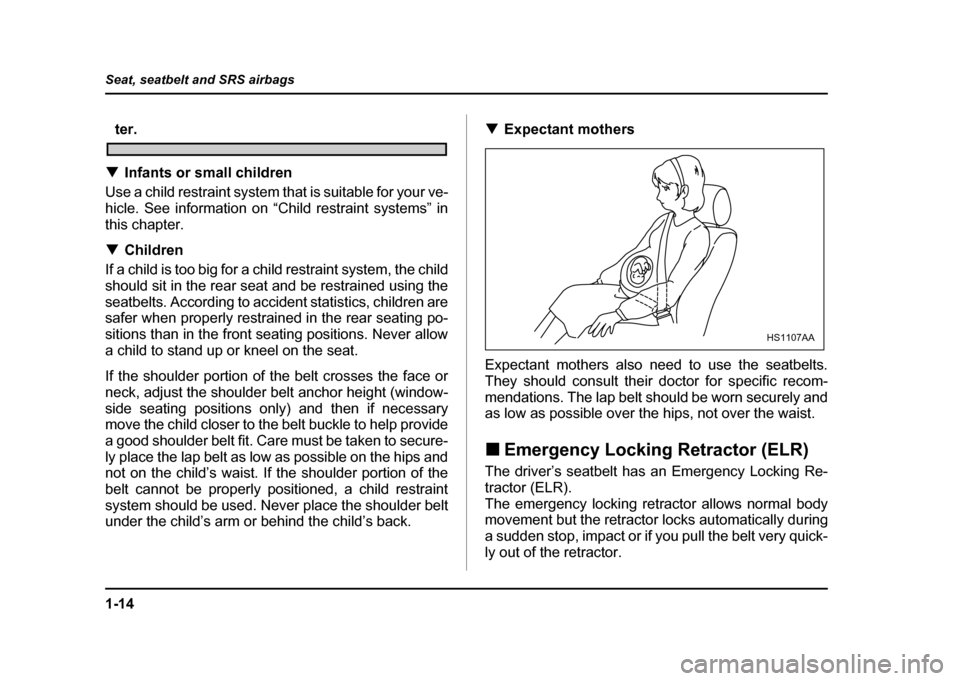
1-14
Seat, seatbelt and SRS airbags
ter.
! Infants or small children
Use a child restraint system that is suitable for your ve-
hicle. See information on “Child restraint systems” in this chapter. ! Children
If a child is too big for a child restraint system, the child
should sit in the rear seat and be restrained using the
seatbelts. According to accident statistics, children are
safer when properly restrained in the rear seating po-
sitions than in the front seating positions. Never allow
a child to stand up or kneel on the seat.
If the shoulder portion of the belt crosses the face or
neck, adjust the shoulder belt anchor height (window-
side seating positions only) and then if necessary
move the child closer to the belt buckle to help provide
a good shoulder belt fit. Care must be taken to secure-
ly place the lap belt as low as possible on the hips and
not on the child’s waist. If the shoulder portion of the
belt cannot be properly positioned, a child restraint
system should be used. Never place the shoulder belt
under the child’s arm or behind the child’s back. !
Expectant mothers
Expectant mothers also need to use the seatbelts.
They should consult their doctor for specific recom-
mendations. The lap belt should be worn securely and
as low as possible over the hips, not over the waist. ! Emergency Locking Retractor (ELR)
The driver’s seatbelt has an Emergency Locking Re-
tractor (ELR).
The emergency locking retractor allows normal body
movement but the retractor locks automatically during
a sudden stop, impact or if you pull the belt very quick-
ly out of the retractor.
HS1107AA
Page 42 of 491
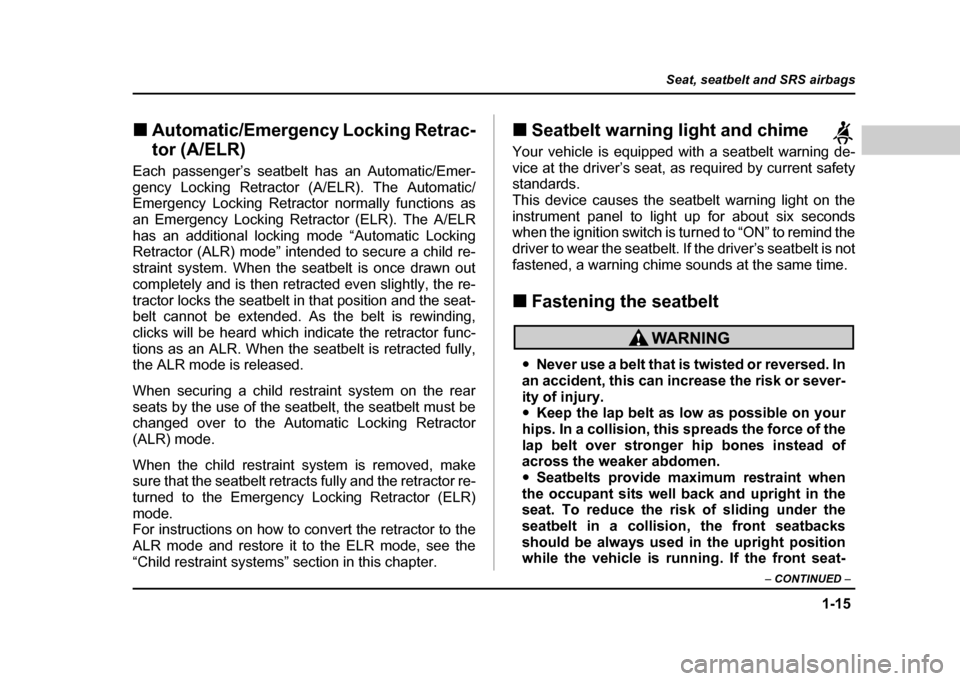
1-15
Seat, seatbelt and SRS airbags
– CONTINUED –
!Automatic/Emergency Locking Retrac- tor (A/ELR)
Each passenger’s seatbelt has an Automatic/Emer-
gency Locking Retractor (A/ELR). The Automatic/
Emergency Locking Retractor normally functions as
an Emergency Locking Retractor (ELR). The A/ELR
has an additional locking mode “Automatic Locking
Retractor (ALR) mode” intended to secure a child re-
straint system. When the seatbelt is once drawn out
completely and is then retracted even slightly, the re-
tractor locks the seatbelt in that position and the seat-
belt cannot be extended. As the belt is rewinding,
clicks will be heard which indicate the retractor func-
tions as an ALR. When the seatbelt is retracted fully,
the ALR mode is released.
When securing a child restraint system on the rear
seats by the use of the seatbelt, the seatbelt must be
changed over to the Automatic Locking Retractor (ALR) mode.
When the child restraint system is removed, make
sure that the seatbelt retracts fully and the retractor re-
turned to the Emergency Locking Retractor (ELR)
mode.
For instructions on how to convert the retractor to the
ALR mode and restore it to the ELR mode, see the
“Child restraint systems” section in this chapter. !
Seatbelt warning light and chime
Your vehicle is equipped with a seatbelt warning de-
vice at the driver’s seat, as required by current safety
standards.
This device causes the seatbelt warning light on the
instrument panel to light up for about six seconds
when the ignition switch is turned to “ON” to remind the
driver to wear the seatbelt. If the driver’s seatbelt is not
fastened, a warning chime sounds at the same time. ! Fastening the seatbelt
"Never use a belt that is twisted or reversed. In
an accident, this can increase the risk or sever-
ity of injury. " Keep the lap belt as low as possible on your
hips. In a collision, this spreads the force of the
lap belt over stronger hip bones instead of
across the weaker abdomen. " Seatbelts provide maximum restraint when
the occupant sits well back and upright in the
seat. To reduce the risk of sliding under the
seatbelt in a collision, the front seatbacks
should be always used in the upright position
while the vehicle is running. If the front seat-
Page 43 of 491
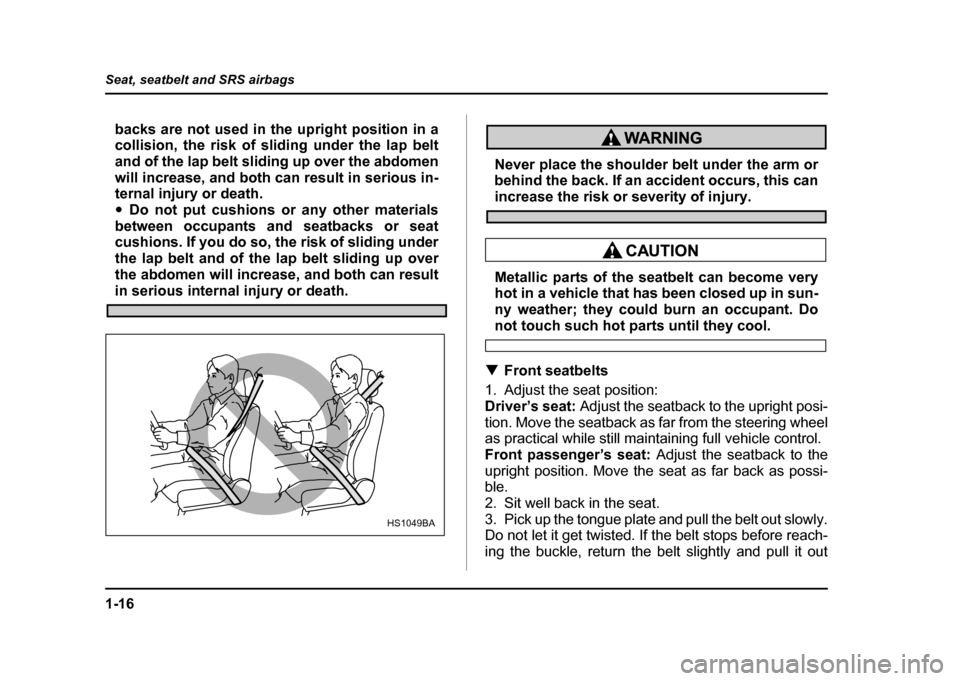
1-16
Seat, seatbelt and SRS airbags
backs are not used in the upright position in a
collision, the risk of sliding under the lap belt
and of the lap belt sliding up over the abdomen
will increase, and both can result in serious in-
ternal injury or death. "
Do not put cushions or any other materials
between occupants and seatbacks or seat
cushions. If you do so, the risk of sliding under
the lap belt and of the lap belt sliding up over
the abdomen will increase, and both can result
in serious internal injury or death.
Never place the shoulder belt under the arm or
behind the back. If an accident occurs, this can
increase the risk or severity of injury.
Metallic parts of the seatbelt can become very
hot in a vehicle that has been closed up in sun-
ny weather; they could burn an occupant. Do
not touch such hot parts until they cool.
! Front seatbelts
1. Adjust the seat position:
Driver’s seat: Adjust the seatback to the upright posi-
tion. Move the seatback as far from the steering wheel
as practical while still maintaining full vehicle control.
Front passenger’s seat: Adjust the seatback to the
upright position. Move the seat as far back as possi-
ble.
2. Sit well back in the seat.
3. Pick up the tongue plate and pull the belt out slowly.
Do not let it get twisted. If the belt stops before reach-
ing the buckle, return the belt slightly and pull it out
HS1049BA
Page 44 of 491
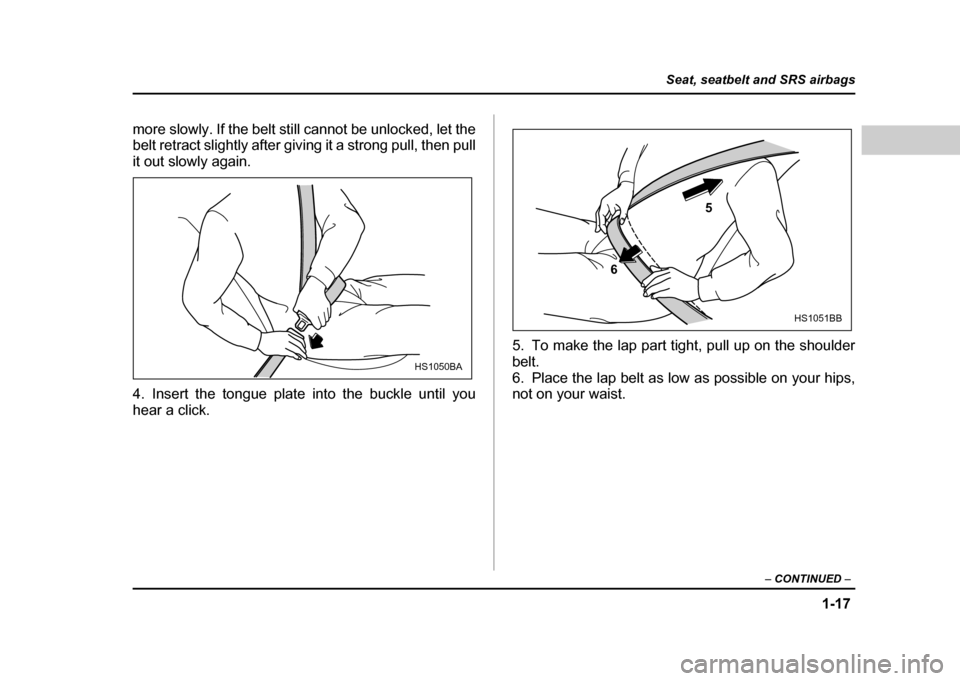
1-17
Seat, seatbelt and SRS airbags
– CONTINUED –
more slowly. If the belt still cannot be unlocked, let the
belt retract slightly after giving it a strong pull, then pull
it out slowly again.
4. Insert the tongue plate into the buckle until you
hear a click. 5. To make the lap part tight, pull up on the shoulder
belt.
6. Place the lap belt as low as possible on your hips,
not on your waist.
HS1050BA
5
6
HS1051BB
Page 45 of 491
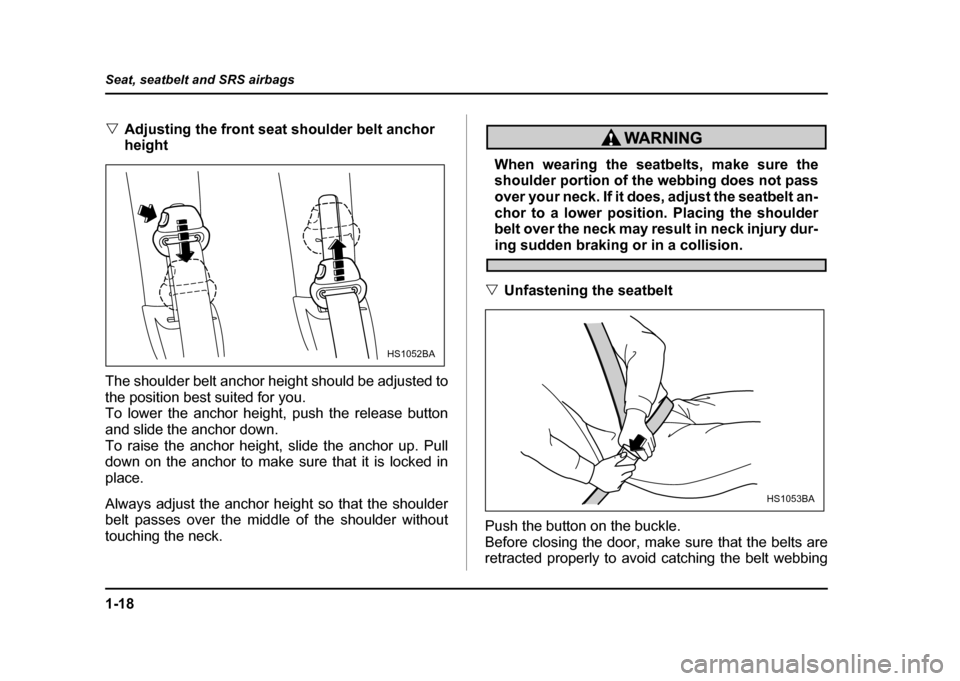
1-18
Seat, seatbelt and SRS airbags
"
Adjusting the front seat shoulder belt anchor
height
The shoulder belt anchor height should be adjusted to
the position best suited for you.
To lower the anchor height, push the release button
and slide the anchor down.
To raise the anchor height, slide the anchor up. Pull
down on the anchor to make sure that it is locked in
place.
Always adjust the anchor height so that the shoulder
belt passes over the middle of the shoulder without
touching the neck.
When wearing the seatbelts, make sure the
shoulder portion of the webbing does not pass
over your neck. If it does, adjust the seatbelt an-
chor to a lower position. Placing the shoulder
belt over the neck may result in neck injury dur-
ing sudden braking or in a collision.
" Unfastening the seatbelt
Push the button on the buckle.
Before closing the door, make sure that the belts are
retracted properly to avoid catching the belt webbing
HS1052BA
HS1053BA
Page 46 of 491
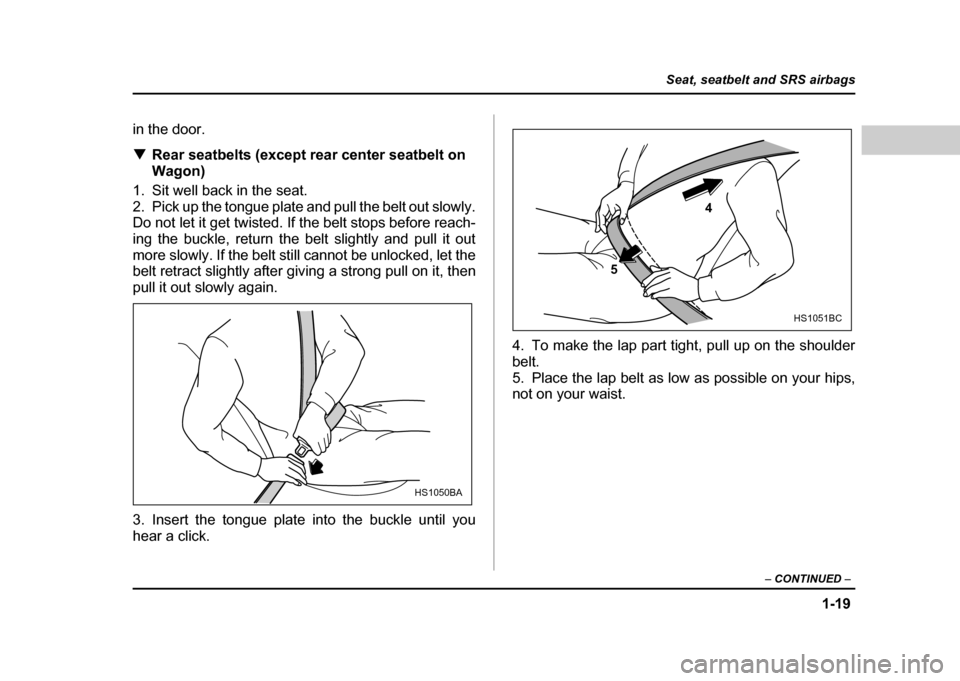
1-19
Seat, seatbelt and SRS airbags
– CONTINUED –
in the door. !Rear seatbelts (except rear center seatbelt on
Wagon)
1. Sit well back in the seat.
2. Pick up the tongue plate and pull the belt out slowly.
Do not let it get twisted. If the belt stops before reach-
ing the buckle, return the belt slightly and pull it out
more slowly. If the belt still cannot be unlocked, let the
belt retract slightly after giving a strong pull on it, then
pull it out slowly again.
3. Insert the tongue plate into the buckle until you
hear a click. 4. To make the lap part tight, pull up on the shoulder
belt.
5. Place the lap belt as low as possible on your hips,
not on your waist.
HS1050BA
4
5
HS1051BC
Page 47 of 491
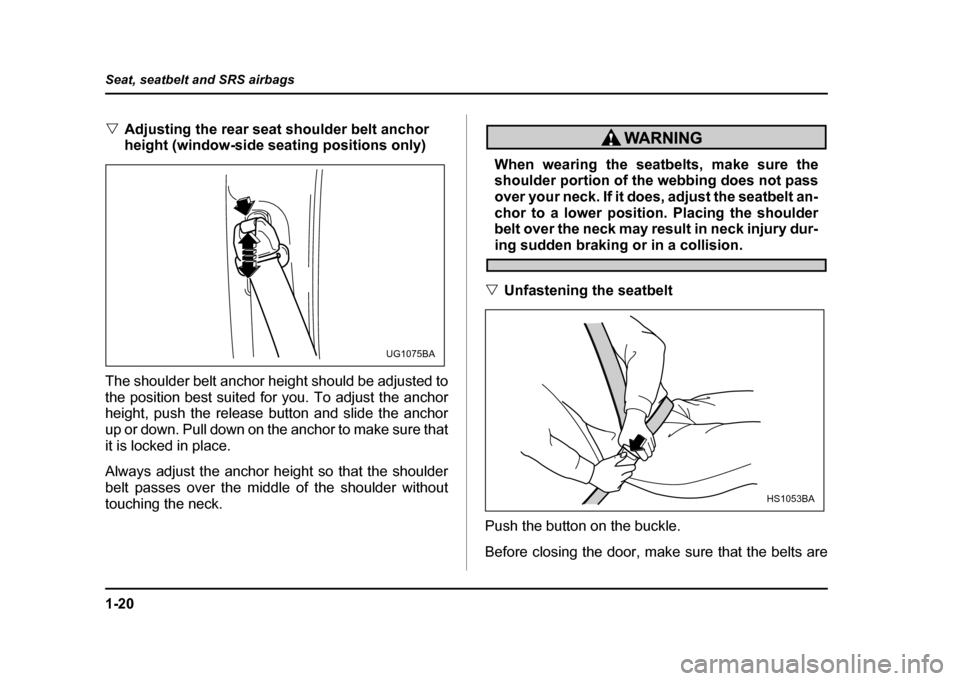
1-20
Seat, seatbelt and SRS airbags
"
Adjusting the rear seat shoulder belt anchor
height (window-side seating positions only)
The shoulder belt anchor height should be adjusted to
the position best suited for you. To adjust the anchor
height, push the release button and slide the anchor
up or down. Pull down on the anchor to make sure that
it is locked in place.
Always adjust the anchor height so that the shoulder
belt passes over the middle of the shoulder without
touching the neck.
When wearing the seatbelts, make sure the
shoulder portion of the webbing does not pass
over your neck. If it does, adjust the seatbelt an-
chor to a lower position. Placing the shoulder
belt over the neck may result in neck injury dur-
ing sudden braking or in a collision.
" Unfastening the seatbelt
Push the button on the buckle.
Before closing the door, make sure that the belts are
UG1075BA
HS1053BA
Page 48 of 491
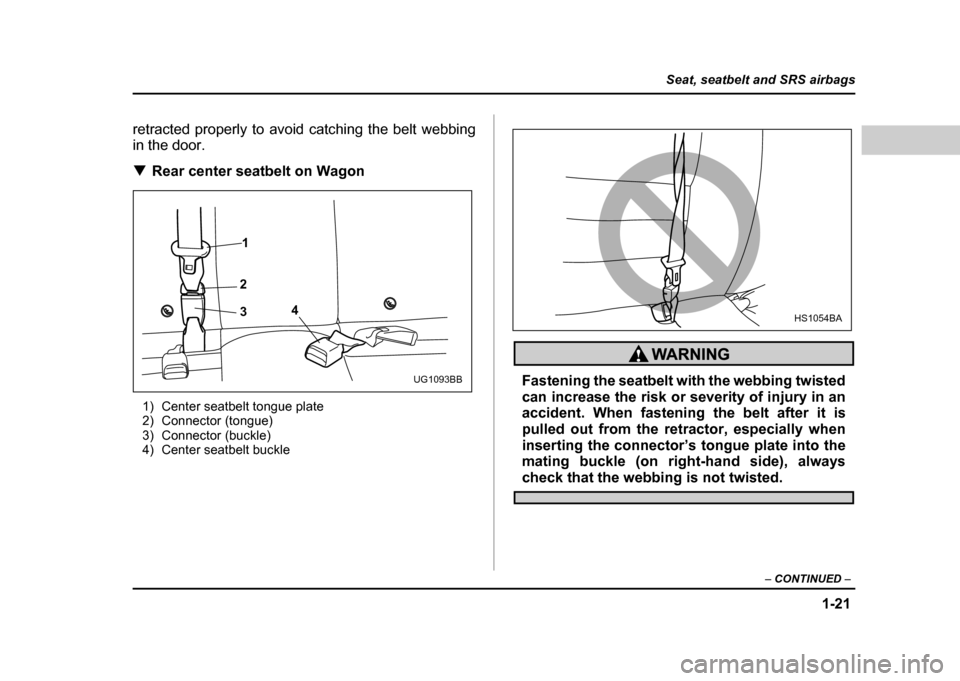
1-21
Seat, seatbelt and SRS airbags
– CONTINUED –
retracted properly to avoid catching the belt webbing
in the door. !Rear center seatbelt on Wagon
1) Center seatbelt tongue plate
2) Connector (tongue)
3) Connector (buckle)
4) Center seatbelt buckle
Fastening the seatbelt with the webbing twisted
can increase the risk or severity of injury in an
accident. When fastening the belt after it is
pulled out from the retractor, especially when
inserting the connector’s tongue plate into the mating buckle (on right-hand side), always
check that the webbing is not twisted.
3 4
1
2
UG1093BB
HS1054BA
Page 49 of 491
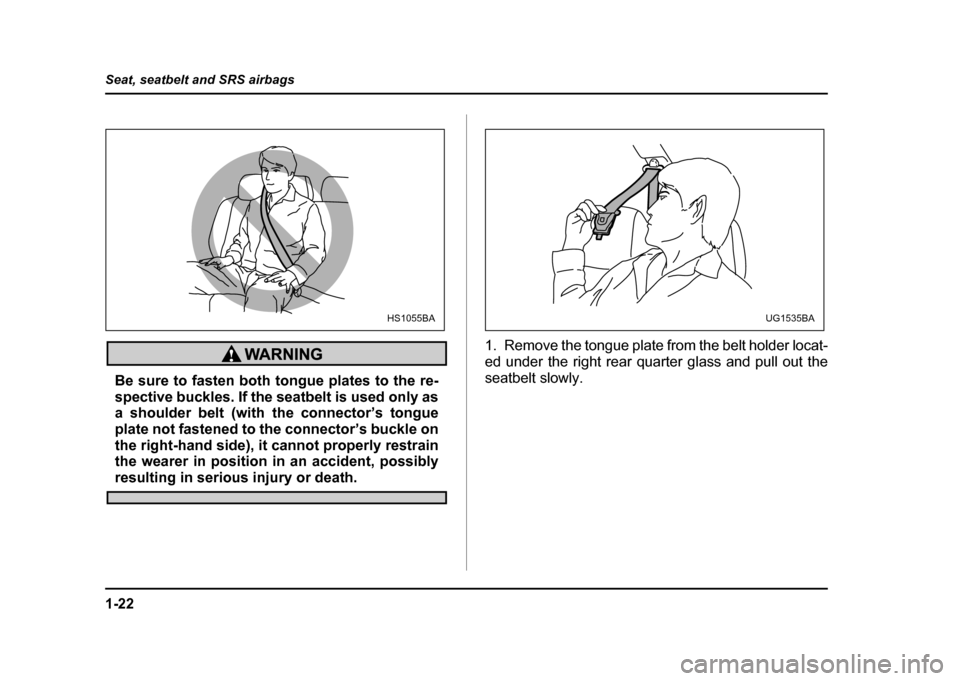
1-22
Seat, seatbelt and SRS airbags
Be sure to fasten both tongue plates to the re-
spective buckles. If the seatbelt is used only as
a shoulder belt (with the connector’s tongue
plate not fastened to the connector’s buckle on
the right-hand side), it cannot properly restrain
the wearer in position in an accident, possibly
resulting in serious injury or death.
1. Remove the tongue plate from the belt holder locat-
ed under the right rear quarter glass and pull out the
seatbelt slowly.
HS1055BAUG1535BA
Page 50 of 491
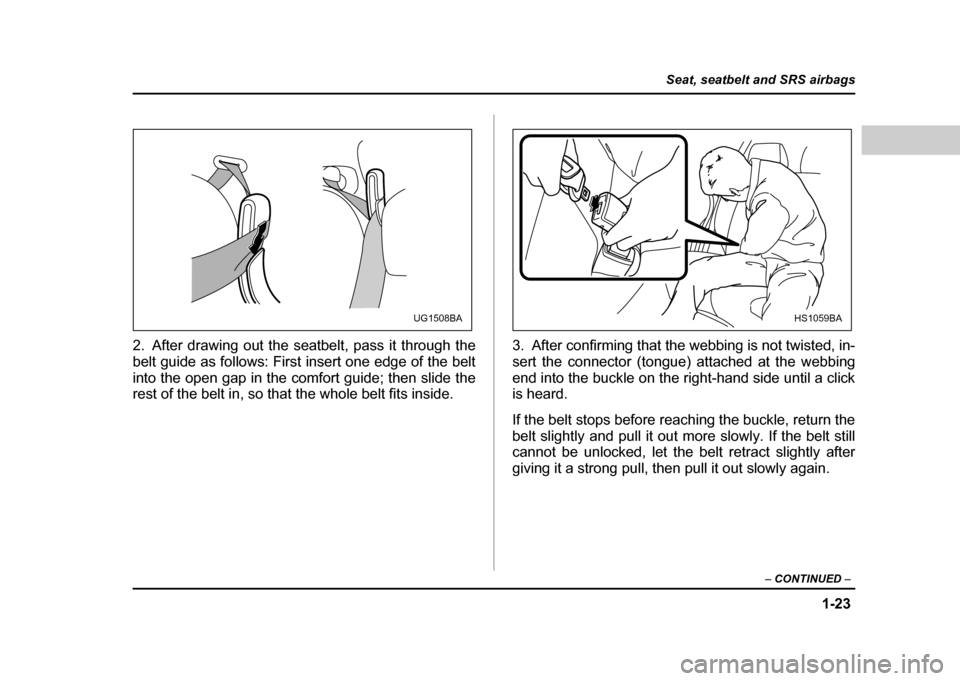
1-23
Seat, seatbelt and SRS airbags
– CONTINUED –
2. After drawing out the seatbelt, pass it through the
belt guide as follows: First insert one edge of the belt
into the open gap in the comfort guide; then slide the
rest of the belt in, so that the whole belt fits inside. 3. After confirming that the webbing is not twisted, in-
sert the connector (tongue) attached at the webbing
end into the buckle on the right-hand side until a click
is heard.
If the belt stops before reaching the buckle, return the
belt slightly and pull it out more slowly. If the belt still
cannot be unlocked, let the belt retract slightly after
giving it a strong pull, then pull it out slowly again.
UG1508BAHS1059BA